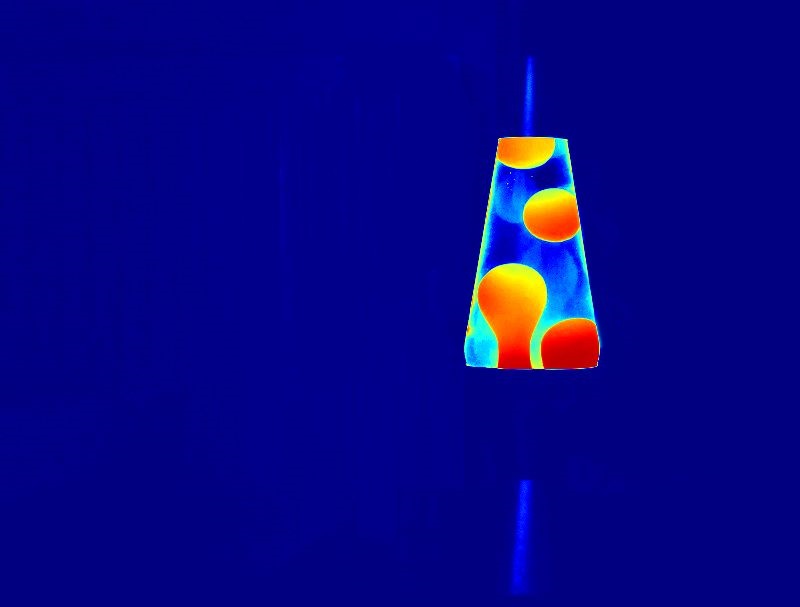Lava lamp
 Lava lamp. Image: George Demetri
Lava lamp. Image: George Demetri
Contents |
[edit] Introduction
One of the most familiar products of the 1960s, the Lava® lamp is symbolic perhaps of both psychedelia and hippy culture. The colourful, cocktail shaker-shaped, illuminated table lamp is instantly recognisable thanks to its sloping glass middle section and floating wax bubbles. It has proved a best-seller over six decades and is still widely available in various colour combinations. The inventor, WW2 RAF squadron leader and engineer Craven Walker, is quoted as saying that if people bought his lamp, they would not need to take drugs.
[edit] Background
Walker got his inspiration for the Lava® lamp while in an English pub where he noticed a strange egg-timer device shaped like a cocktail shaker bubbling away on a stove. This inspired him to set up his own company to develop a special lamp that would provide light and feature a mesmerising display of wax globules in constant, slow-motion animation, activated by the heat from an incandescent light bulb (typically 25W or 40W) housed below the glass.
The rising and falling of the wax through the coloured liquid provides the two-toned signature style of the lamp: red-orange, blue-green, yellow-mauve and other striking colour combinations. Once the wax cools, it sinks to the bottom of the glass container, passing rising globules as it does so, then it is subsequently reheated and rises upwards to begin another cycle.
At normal room temperature, a Lava-lamp can take around 45-60 minutes to heat up and to put the wax globules in motion.
Creating this effect and achieving the right balance between wax, oil and water took Crestworth – the company Walker set up – around 10 years to perfect, in a design heavily influenced by the space rockets popularised in 60s science-fiction films and literature. With another nod to its interstellar inspiration, Walker named his invention the Astro lamp and applied for a patent in 1964. Once it went on sale, the lamp became an instant hit. Walker would continue to make minor improvements up till 1967.
[edit] Selling the lamp
Sales of the Lava-lamp flagged in the 1980s. In 1990, Walker sold his company to an entrepreneur by the name of Cressida Granger, who was to later rename the company Mathmos and which still develops kinetic lighting products.
The rights to sell the lamp in the US and worldwide were bought by two businessmen who saw the lamp while on a trade mission to Europe in 1965. They renamed it Lava® lamp and formed the Lava Corporation of Chicago. Today, the lamp is marketed and sold in the US by Schylling.
The Lava® lamp is available in a wide range of wax/liquid combinations, body finishes and shapes.
[edit] Related articles on Designing Buildings Wiki
- Artificial lighting.
- Colour.
- Colour appearance.
- General lighting v task lighting.
- Health and wellbeing impacts of natural and artificial lighting.
- Illuminance.
- Lamp efficacy.
- Light fitting.
- Luminous flux.
- Power factor.
- The essential guide to retail lighting.
- The impact of lighting in retail design.
- Types of lamp.
- Types of lighting.
Featured articles and news
Latest Build UK Building Safety Regime explainer published
Key elements in one short, now updated document.
UKGBC launch the UK Climate Resilience Roadmap
First guidance of its kind on direct climate impacts for the built environment and how it can adapt.
CLC Health, Safety and Wellbeing Strategy 2025
Launched by the Minister for Industry to look at fatalities on site, improving mental health and other issues.
One of the most impressive Victorian architects. Book review.
Common Assessment Standard now with building safety
New CAS update now includes mandatory building safety questions.
RTPI leader to become new CIOB Chief Executive Officer
Dr Victoria Hills MRTPI, FICE to take over after Caroline Gumble’s departure.
Social and affordable housing, a long term plan for delivery
The “Delivering a Decade of Renewal for Social and Affordable Housing” strategy sets out future path.
A change to adoptive architecture
Effects of global weather warming on architectural detailing, material choice and human interaction.
The proposed publicly owned and backed subsidiary of Homes England, to facilitate new homes.
How big is the problem and what can we do to mitigate the effects?
Overheating guidance and tools for building designers
A number of cool guides to help with the heat.
The UK's Modern Industrial Strategy: A 10 year plan
Previous consultation criticism, current key elements and general support with some persisting reservations.
Building Safety Regulator reforms
New roles, new staff and a new fast track service pave the way for a single construction regulator.
Architectural Technologist CPDs and Communications
CIAT CPD… and how you can do it!
Cooling centres and cool spaces
Managing extreme heat in cities by directing the public to places for heat stress relief and water sources.
Winter gardens: A brief history and warm variations
Extending the season with glass in different forms and terms.
Restoring Great Yarmouth's Winter Gardens
Transforming one of the least sustainable constructions imaginable.






















